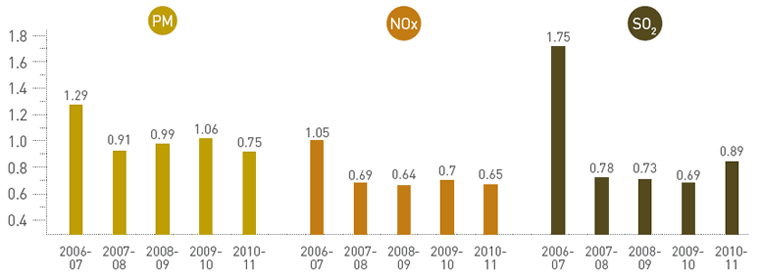|
All other units also strive towards reducing the specific emission levels. Some of the units which significantly reduced the specific emission levels and their percentage improvement over the last year is depicted below:
| Unit |
Percentage improvement in specific emission of |
| PM |
NOx |
SO2 |
| Cast coating
Unit, Bollaram |
7.6 |
6.3 |
13.2 |
| Snacks Unit
Haridwar |
58.6 |
12.3 |
50.6 |
The specific emission levels in the Cigarette Business for the last 5 years are illustrated in the graph below:
Cigarette Business - Specific Emissions in Kg/Million Cigarettes

Ozone depleting substances (ODS)
In accordance with Government of India’s ODS Rules, 2000, which was formulated to comply with Montreal Protocol, 1987 which regulates/bans the use of ozone depleting substances internationally, ITC has developed and implemented an ODS phase out plan.
The salient features of ITC’s Plan on ODS phase out are –
 |
All newly purchased equipment to be free of Chlorofluorocarbons (CFC), Halons and Methyl Chloroform (MCF). |
| |
|
 |
All units to monitor and reduce consumption of ODS. |
| |
|
 |
Replace all the existing equipment using ODS well before the phase out stipulation. |
| |
|
 |
Recover all the ODS from the equipment being replaced for recycling or safe disposal. |
In 2010-11, the total consumption of ODS by all our Units was 139 Kg of CFC-11 equivalent.
Responsible management of chemicals, oils and fuels
All our Units manage chemicals, oils and fuels as per defined ITC norms, which take into account all statutory requirements, and international best practices. These norms are considered right from design stage and include measures for leakage/ spillage prevention, containment provisions, impervious flooring, leak detection system and all requirements as per Material Safety Data Sheets (MSDS) for hazardous chemicals. Safe work practices on handling & storage, procedures for leak detection & spill control and preventive maintenance have been instituted to avoid any incidence of uncontrolled spills or leakage. The effectiveness of these measures is checked on a regular basis.
We also continuously evaluate the feasibility of substituting hazardous chemicals with less or non-hazardous materials.
In 2010-11, there was no significant spill of any chemicals, oils, fuels or hazardous wastes in any of our Units.
Biodiversity
Our Units/operations do not have any significant impact on biodiversity.
All the new/expansion projects have been undertaken after due Environmental Impact Assessments (EIA) and stakeholder consultations, as applicable. Environmental Management Plans where required as per the EIA studies, are implemented along with projects.
Beyond compliance
All our Units are committed to implementing state-of-the-art processes and technologies and achieving benchmarked performance.
Environment, Occupational Health & Safety management systems in our Units conform to international standards such as ISO 14001/OHSAS 18001/HACCP etc. and are certified by accredited 3rd Party agencies.
Besides business division wise internal audits and other 3rd party audits, Corporate EHS experts audit every unit at periodic intervals not exceeding 18 months, to ensure compliance to statutory norms and Corporate EHS requirements.
During 2010-11, no violation of environmental laws/ regulations was recorded in any ITC Unit.
|

